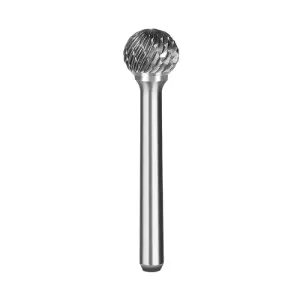Hardness and Cutting Efficiency
One of the significant advantages of carbide rotary burs over high-speed steel (HSS) files is their good hardness. Carbide, being a composite of carbon and tungsten, is considerably harder than HSS, which means it can maintain a sharper cutting edge for a longer period of time. This good hardness allows carbide tools to cut through extremely tough materials such as hardened steel, stainless steel, cast iron, and even certain ceramics with minimal wear. As a result, the cutting efficiency is greatly improved, causing faster material removal rates and reduced processing time in both manual and machine-driven operations.

Longer Tool Life in Demanding Environments
Durability is a key factor in tool selection, and carbide rotary burs significantly outperform HSS files in this regard. The wear resistance of carbide allows it to withstand prolonged use under high-stress conditions without chipping or dulling quickly. In contrast, HSS files, while more economical, tend to lose their cutting effectiveness more rapidly when used on hard or abrasive surfaces. For industries where tools are expected to perform consistently across repetitive cycles—such as aerospace, automotive, and die casting—carbide options reduce the frequency of replacements and downtime, ultimately causing cost savings over time despite the higher initial investment.
Better Performance at Higher Speeds
Carbide rotary burs are capable of operating effectively at much higher speeds than HSS files without compromising safety or performance. This makes them ideal for use in high-speed rotary tools, CNC machines, and die grinders where precision and consistency are critical. At elevated RPMs, carbide maintains its structural integrity and cutting accuracy, whereas HSS may become prone to deformation, heat damage, or loss of hardness. This speed advantage also contributes to smoother finishes on the workpiece and supports more aggressive material removal when required.
Enhanced Versatility Across Applications
While HSS files are limited in their application range due to their lower hardness, carbide rotary burs can be used on a wide variety of materials, including ferrous and non-ferrous metals, plastics, composites, and even stone. This versatility makes them a go-to solution for professionals who require a single tool to handle multiple tasks such as deburring, shaping, enlarging holes, or surface finishing. The availability of carbide burs in numerous shapes and flute patterns further enhances their adaptability, allowing users to select specific configurations tailored to each task for suitable results.
Precision and Surface Finish Advantages
When fine detail and surface quality are critical, carbide rotary burs offer a good finish compared to HSS files. Their sharpness and rigidity ensure chatter and vibration during cutting, which translates to smoother and more precise results. This makes them particularly suitable for intricate metalwork, mold making, and fine engraving, where even slight imperfections can compromise the final product. In contrast, HSS files may leave rougher finishes and require additional polishing or rework to achieve the desired surface quality.
Conclusion
Although high-speed steel files have their place in general-purpose applications, carbide rotary burs offer a range of advantages that make them more suitable for demanding industrial environments. From good hardness and extended tool life to higher speed capability, greater versatility, and better surface finishes, these tools are a valuable asset for professionals seeking efficiency, durability, and precision. Choosing carbide over HSS ultimately results in reduced maintenance, improved productivity, and better quality outcomes across a wide array of fabrication and manufacturing tasks.